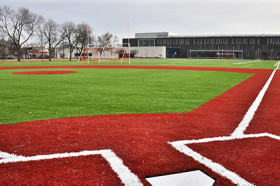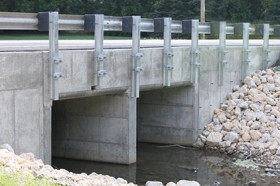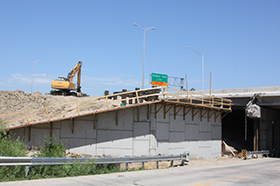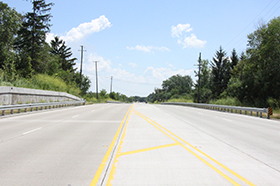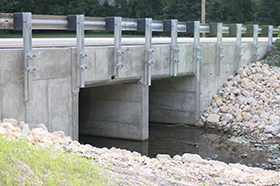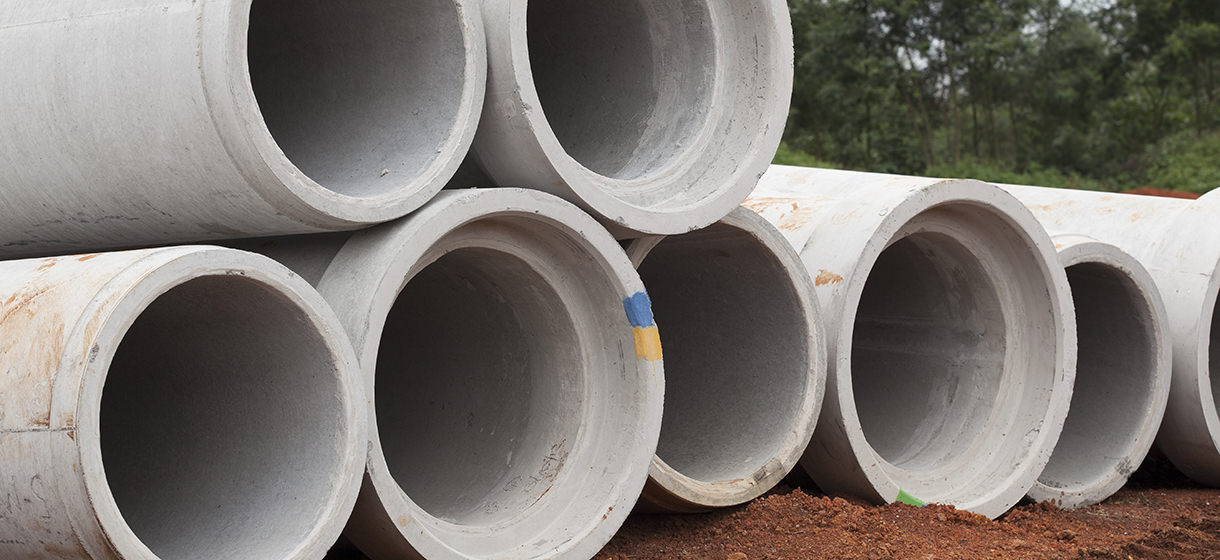
Adequate stormwater and drainage is vital in the design of roadways as it impacts a roadway’s serviceability, safety, and strength. Frequently, during the design process for a roadway rehabilitation or reconstruction project, pavement design and stormwater drainage designs are completed by different teams or individuals. Yet, integrating these two disciplines during the design process can make a significant difference in the long-term functionality and maintenance of the roadway. This article takes a look into alternate solutions and considerations for curb and gutter sections, storm sewer connections, pavement structures and debris management that can positively impact the quality of the designs.
Curb and Gutter Sections
The size and type of curb and gutters specified can impact the life cycle of the roadway. For example, many municipalities use an IDOT Type B6.12 Curb and Gutter with a Type 1 circular frame, a frame which protrudes out into the pavement. If the pavement is asphalt, it is extremely difficult to get adequate compaction along the edge of the frame during asphalt paving. If the pavement is concrete, this introduces a problem with respect to forming the edge. Either way, a discontinuity has been introduced into the edge of the pavement that will eventually fail prematurely, causing the inevitable potholes we see all too often. It should also be noted that because of the presence of a drainage structure, these locations are frequently at low points in the pavement where stormwater naturally collects.
An alternate solution to this issue is to use a heavier type curb and gutter section, such as the IDOT Type B6.24. While more expensive, this section offers a more robust structural section that will last longer than the thinner B6.12. It also offers advantages in that it can convey more water in the gutter line, thus enabling greater inlet structure spacing with a commensurate offset in cost. The 24-inch gutter also allows the inlet frame to be entirely contained within the gutter section, thus enabling a continuous pavement edge line with no interruptions.
Another advantage to using the 24-inch gutter is that it allows for the use of a Type 24 square vane grate which has a higher hydraulic capacity than a Type 1 circular grate. Either one is preferable to a 12 or 18-inch frame which makes it difficult to get a Vactor suction tube into the structure for cleaning. The additional cost of the wider gutter will be more than offset by future maintenance crew costs when factoring in the time it takes to clean the structure.
Some designers have also “bumped out” the curb and gutter section in order to accommodate a larger structure frame while using a smaller gutter section. Unfortunately, snow plows tend to plow with the right edge of their plow riding against the curb, which results in the “bumpout” being beaten to fragments by the plow as well as possibly damaging the vehicle. These “bumpouts” are also problematic in terms of street sweeping, since the sweeper broom usually cannot get into the area most critical to be cleaned.
Overall, larger gutter sections are the preferred option for the reasons listed above. Additionally, since many municipalities use a curb-to-curb width standard for their roadway sections, increased gutter widths will result in a reduction in the pavement width, which ultimately reduces the cost.
Storm Sewer Connections
Many agencies do not allow “blind” connections in storm sewer pipe runs. A blind connection is where a storm sewer connects to another without the benefit of a structure such as a manhole. For example, consider a four-lane median-separated facility with a depressed mountable center median. A typical lateral run consists of a 12- or 15-inch lateral starting from a catch basin on the north side, then discharging south to the center median catch basin, where another run continues south to the south edge catch basin. From there, another pipe discharges south into a main drain located in the south parkway. The assumption is that any end of the pipe can be accessed from a structure, thus enabling cleaning, but a blocked structure in this type of design will result in a backup of the entire upstream system.
An alternate solution to this common practice would be to run the lateral from the north structure straight into the main drain on the south side, with two “wye” connections to pick up the median and south side catch basins. This has several advantages, the primary one being that should any of the structures fill or become blocked, the other structures on the lateral line will not be affected. The second advantage is that it eliminates two knockouts/connections in the catch basins, which can be a common source of failure. Usually the lateral run is located only a couple of feet away from the structure, so in the unlikely case of something jamming at the “wye” connection, it can be reached from the adjacent structure. The “wye” connection can be cast integrally with the pipe so that a field connection is not necessary, and the bell is already in the side of the pipe.
Eliminating Structures
If an agency is reconstructing or even rehabilitating a roadway, consideration should be given to moving or eliminating structures out of the pavement. These locations are one of the most common causes of pavement failure due to differential settlement around the structures, snowplow blade impacts, and warped lids to name a few. While not always practical or even possible, consideration should be given to relocating the main drain behind the curb on one side or the other.
If elimination of structures in the pavement isn’t an option, consider keeping the frame location in the center of the lane and out of the wheel path. Driving down a road and over manhole frames in the wheel path every 200 feet or so can be frustrating for drivers. Likewise, transverse crossings should have manhole structures located outside of the pavement as well.
Debris Management
For areas with high volumes of debris, oversized catch basins should be considered. These frequently occur at low points, bridge approach bottoms, or near railroad tracks where the rails tend to knock off debris from the underside of vehicles, especially during winter. A standard size catch basin is 48-inches in diameter, but there is nothing preventing a designer from specifying a 60, 72 or even 96-inch diameter structure. Similarly, increasing the sump depth creates additional storage capacity before the debris makes its way up to the lateral discharge invert. In either case, the idea here is to balance out the cleaning cycle times of the structures on the roadway. If catch basins need to be cleaned every five years, but the ones by the tracks need cleaning every two years, then the design is counterproductive.
There are many other options for optimizing roadway designs, but in any case, collaboration between the pavement and stormwater/drainage designers can positively impact a rehabilitation or reconstruction project. Consideration for the long-term impact of each design decision and creative solutions can result in better facilities for our clients and their end users.
For more information on roadway and stormwater design, please contact Mark Johnson.


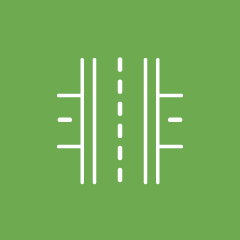



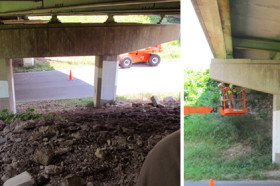
 An Emphasis on Maintenance May Save You Money
An Emphasis on Maintenance May Save You Money 
